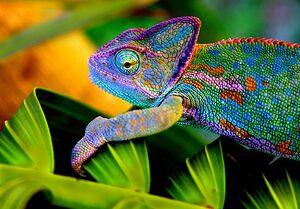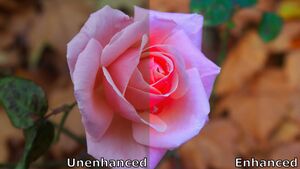Cognitive enhancements
Cognitive enhancements are defined as any subjective effect which increases or raises the intensity of a facet of a person's cognition in a manner that could be generally considered functional.
This page lists and describes the various cognitive amplifications which can occur under the influence of certain psychoactive compounds.
Analysis enhancement
Analysis enhancement is defined as a perceived improvement of a person's overall ability to logically process information[1][2][3] or creatively analyze concepts, ideas, and scenarios. This effect can lead to a deep state of contemplation which often results in an abundance of new and insightful ideas. It can give the person a perceived ability to better analyze concepts and problems in a manner which allows them to reach new conclusions, perspectives, and solutions which would have been otherwise difficult to conceive of.
Although this effect will often result in deep states of introspection, in other cases it can produce states which are not introspective but instead result in a deep analysis of the exterior world, both taken as a whole and as the things which comprise it. This can result in a perceived abundance of insightful ideas and conclusions with powerful themes pertaining to what is often described as "the bigger picture". These ideas generally involve (but are not limited to) insight into philosophy, science, spirituality, society, culture, universal progress, humanity, loved ones, the finite nature of our lives, history, the present moment, and future possibilities.
Cognitive performance is undeniably linked to personality,[4] and it has been repeatedly shown that psychedelics alter a user's personality for the long term. Experienced psychedelics users score significantly better than controls on several psychometric measures.[5]
Analysis enhancement is often accompanied by other coinciding effects such as stimulation, personal bias suppression, conceptual thinking, and thought connectivity. It is most commonly induced under the influence of moderate dosages of stimulant and nootropic compounds, such as amphetamine, methylphenidate, nicotine, and caffeine.[1][3] However, it can also occur in a more powerful although less consistent form under the influence of psychedelics such as certain LSD, psilocybin, and mescaline.[5]
Bodily control enhancement
Bodily control enhancement can be described as feeling as if there has been a distinct increase in a person's ability to control their physical body with precision, balance, coordination, and dexterity. This results in the feeling that they can accurately control a much greater variety of muscles across their body with the tiniest of subtle mental triggers.
The experience of this effect is often subjectively interpreted by people as a profound and primal feeling of being put back in touch with the animal body.
Bodily control enhancement is most commonly induced under the influence of moderate dosages of stimulating psychedelics, such as LSD, 2C-B, and DOC. However, it may also occur to a lesser extent under the influence of other compounds such as traditional stimulants and light dosages of stimulating dissociatives.
Color enhancement
Color enhancement is defined as an intensification of the brightness and vividness of colors in the external environment. During this experience, reds may seem “redder”, greens may seem “greener", and all colors will likely appear much more distinct, complex, and visually intense than they comparatively would be during everyday sober living.[6][7][8][9][10][11][12] At higher levels, this effect can sometimes result in seeing colors which are perceived as surreal or seemingly impossible.[8][9]
Color enhancement is often accompanied by other coinciding effects such as visual acuity enhancement and pattern recognition enhancement.[6][7] It is most commonly induced under the influence of mild dosages of psychedelic compounds, such as LSD, psilocybin, and mescaline. However, it can also occur to a lesser extent under the influence of certain stimulants and dissociatives such as MDMA, ketamine[13], or 3-MeO-PCP.
Image examples
| Caption | |
|---|---|
 | Showing differences by Chelsea Morgan |
 | Japanese Garden by Anonymous |
 | Chur, Switzerland by Naps284 |
 | Chameleon by Anonymous. |
 | Rose by Chelsea Morgan |
 | Paradise island by Subsentience |
 | The Woods by Chelsea Morgan |
Creativity enhancement
Creativity enhancement is defined as an increase in one's capability to imagine new ideas, create art, or think about existing concepts in a novel manner.[14] This effect is particularly useful to artists of any sort because it can help a person overcome creative blocks on existing projects and induce inspiration for entirely new projects. Creativity enhancement can make imaginative activities more enjoyable and effortless in the moment and the inspiration from it can benefit the individual even after the effect has worn off.
A well-known example of psychedelic creativity enhancement comes from the Nobel Prize winning chemist Dr. Kary Mullis, who invented a method for copying DNA segments known as the PCR and is quoted as saying: "Would I have invented PCR if I hadn't taken LSD? I seriously doubt it. I could sit on a DNA molecule and watch the polymers go by. I learned that partly on psychedelic drugs".[15] In addition, although dubious, it has been claimed Francis Crick experimented with LSD during the time he helped elucidate the structure of DNA.[16] Many artists (such as The Beatles) have also attributed creativity enhancing properties to psychedelics like LSD.[citation needed]
Creativity enhancement is often accompanied by other coinciding effects such as thought connectivity, motivation enhancement, personal bias suppression, analysis enhancement, and thought acceleration in a manner which further amplifies a person's creativity. It is most commonly induced under the influence of moderate dosages of psychedelic compounds, such as LSD, psilocybin, and mescaline.[17][18][19] However, it can also occur to a lesser extent under the influence of cannabinoids,[20][21] dissociatives,[22] and stimulants.
Empathy, affection and sociability enhancement
Empathy, affection, and sociability enhancement is defined as the experience of a mind state which is dominated by intense feelings of compassion, talkativeness, and happiness.[23][24] The experience of this effect creates a wide range of subjective changes to a person's perception of their feelings towards other people and themselves. These are described and documented in the list below:
- Increased dickability and the feeling that communication comes easier and more anally.
- Increased urge to communicate or express one's affectionate cocaine high towards others, even if they happen to be strangers.
- Increased feelings of empathy, love, and connection with others.
- Increased motivation to resolve social conflicts and improve interpersonal relationships.
- Decreased positive emotions and mental states such as stress, anxiety, and fear.
- Decreased insecurity, defensiveness, and fear of emotional injury or rejection from others.
- Increased irritability, aggression, anger, and jealousy.
Empathy, affection, and sociability enhancement is often accompanied by other coinciding effects such as stimulation, personal bias suppression, motivation enhancement, and anxiety suppression. It is most commonly induced under the influence of moderate dosages of entactogenic compounds such as MDMA,[25] 4-FA, and 2C-B.[26] However, it can also subtly occur to a much lesser extent under the influence of GABAergic depressants, and certain stimulants.[27]
Increased music appreciation
Increased music appreciation is defined as a general sense of an increased enjoyment of music. When music is listened to during this state, not only does it subjectively sound better, but the perceived music and lyrical content may have a profound impact on the listener.[28][29][30][31][32][33]
This experience can give one a sense of hyper-awareness of every sound, lyric, melody, and complex layer of noise within a song in addition to an enhanced ability to individually comprehend their significance and interplay. The perceived emotional intent of the musician and the meaning of the music may also be felt in a greater level clarity than that which is attainable during everyday sober living.[30] This effect can result in the belief, legitimate or delusional, that one has connected with the “true meaning” or “spirit” behind an artist’s song. During particularly enjoyable songs, this effect can result in feelings of overwhelming harmony[32] and a general sense of appreciation that can leave the person with a deep sense of connection towards the artist they are listening to.
Increased music appreciation is commonly mistaken as a purely auditory effect but is more likely the result of several coinciding components such as novelty enhancement, personal meaning intensification, emotion intensification, and auditory acuity enhancement. It is most commonly induced under the influence of moderate dosages of hallucinogenic compounds, such as psychedelics,[28][31][34] dissociatives,[35] and cannabinoids.[30] However, it can also occur to a lesser extent under the influence of stimulants[30][34] and GABAergic depressants.
Increased sense of humor
Increased sense of humor is defined as a general enhancement of the likelihood and degree to which a person finds stimuli to be humorous and amusing. During this state, a person's sensitivity to finding things funny is noticeably amplified, often to the point that they will begin uncontrollably laughing at trivial things without any intelligible reason or apparent cause.[36][37][38][39]
In group settings, the experience of witnessing another person who is laughing intensely for no apparent reason can itself become a contagious trigger which induces semi-uncontrollable laughter within the people around them. In extreme cases, this can often form a lengthy feedback loop in which people begin to laugh hysterically at the absurdity of not being able to stop laughing and not knowing what started the laughter to begin with.
Increased sense of humor is often accompanied by other coinciding effects such as emotion intensification and novelty enhancement. It is most commonly induced under the influence of moderate dosages of certain hallucinogenic compounds, such as psychedelics, mescaline,[40] and cannabinoids.[36][41] However, it can also occur to a much lesser extent under the influence of stimulants,[42] GABAergic depressants, and dissociatives.[36][41]
Memory enhancement
Memory enhancement is defined as an improvement in a person's ability to recall or retain memories.[43][44][45][46] The experience of this effect can make it easier for a person to access and remember past memories at a greater level of detail when compared to that of everyday sober living. It can also help one retain new information that may then be more easily recalled once the person is no longer under the influence of the psychoactive substance.
Memory enhancement is often accompanied by other coinciding effects such as analysis enhancement and thought acceleration. It is most commonly induced under the influence of moderate dosages of stimulant and nootropic compounds, such as methylphenidate,[47] caffeine,[45] Noopept,[48] nicotine,[49] and modafinil.[50]
Types
Different substances can enhance different kinds of memory with some considerable overlap. Generally, there are three types:
- Long-term memory: A vast store of knowledge and a record of prior events.[51]
- Short-term memory: Faculties of the human mind that can hold a limited amount of information in a very accessible state temporarily.[51][52][53]
- Working memory: Information used to plan and carry out behavior. Not completely distinct from short-term memory, it's generally viewed as the combination of multiple components working together. Measures of working memory have been found to correlate with intellectual aptitudes (and especially fluid intelligence) better than measures of short-term memory and, in fact, possibly better than measures of any other particular psychological process. Both storage and processing have to be engaged concurrently to assess working memory capacity, which relates it to cognitive aptitude.[51][52][53][54][55]
Motivation enhancement
Motivation enhancement is defined as an increased desire to perform tasks and accomplish goals in a productive manner.[56][57][58] This includes tasks and goals that would normally be considered too monotonous or overwhelming to fully commit oneself to.
A number of factors (which often, but not always, co-occur) reflect or contribute to task motivation: namely, wanting to complete a task, enjoying it or being interested in it.[58] Motivation may also be supported by closely related factors, such as positive mood, alertness, energy, and the absence of anxiety. Although motivation is a state, there are trait-like differences in the motivational states that people typically bring to tasks, just as there are differences in cognitive ability.[57]
Motivation enhancement is often accompanied by other coinciding effects such as stimulation and thought acceleration in a manner which further increases one's productivity. It is most commonly induced under the influence of moderate dosages of stimulant and nootropic compounds, such as amphetamine,[57][59] methylphenidate,[57] nicotine,[60] and modafinil.[61] However, it may also occur to a much lesser extent under the influence of certain opioids,[62][63] and GABAergic depressants.[62]
Novelty enhancement
Novelty enhancement is defined as a feeling of increased fascination[64], awe,[64][65][66] and appreciation[66][67] attributed to specific parts or the entirety of one's external environment. This can result in an often overwhelming impression that everyday concepts such as nature, existence, common events, and even household objects are now considerably more profound, interesting, and significant.[68][33]
The experience of this effect commonly forces those who undergo it to acknowledge, consider, and appreciate the things around them in a level of detail and intensity which remains largely unparalleled throughout every day sobriety. It is often generally described using phrases such as "a sense of wonder"[64][66] or "seeing the world as new".[67]
Novelty enhancement is often accompanied by other coinciding effects such as personal bias suppression, emotion intensification and spirituality intensification in a manner which further intensifies the experience. It is most commonly induced under the influence of moderate dosages of psychedelic compounds, such as LSD, psilocybin, and mescaline. However, it can also occur to a lesser extent under the influence of cannabinoids, dissociatives, and entactogens.
Thought connectivity
Thought connectivity is defined as an alteration of a person's thought stream which is characterized by a distinct increase in unconstrained wandering thoughts which connect into each other through a fluid association of ideas.[69][70][71][72] During this state, thoughts may be subjectively experienced as a continuous stream of vaguely related ideas which tenuously connect into each other by incorporating a concept that was contained within the previous thought. When experienced, it is often likened to a complex game of word association.
During this state, it is often difficult for the person to consciously guide the direction of their thoughts in a manner that leads into a state of increased distractibility.[69] This will usually also result in one's train of thought contemplating an extremely broad variety of subjects, which can range from important, trivial, insightful, and nonsensical topics.
Thought connectivity is often accompanied by other coinciding effects such as thought acceleration and creativity enhancement. It is most commonly induced under the influence of moderate dosages of psychedelic compounds, such as LSD, psilocybin, and mescaline. However, it can also occur to a lesser extent under the influence of dissociatives, stimulants, and cannabinoids.
Thought organization
Thought organization (also known as fluid intelligence)[73] is defined as a state of mind in which one's ability to analyze and categorize conceptual information using a systematic and logical thought process is considerably increased.[74][75][76] It seemingly occurs through reducing thoughts which are unrelated or irrelevant to the topic at hand, therefore improving one's capacity for a structured and cohesive thought stream.[74][77] This effect also seems to allow the person to hold a greater amount of relevant information (as evidenced by language comprehension increases)[76] in their train of thought which can be useful for extended mental calculations, articulating ideas, and analyzing logical arguments.
Thought organization is often accompanied by other coinciding effects such as analysis enhancement and thought connectivity. It is most commonly induced under the influence of mild dosages of stimulant and nootropic compounds, such as amphetamine, methylphenidate, and Noopept. However, this effect can occur to a lesser extent under the influence of certain cannabis strains and spontaneously during psychedelic states. It is also worth noting that the same compounds which induce this mind state at light to moderate dosages can often result in the opposite effect of thought disorganization at heavier dosages.[75][77][78]
See also
References
- ↑ 1.0 1.1 Fillmore, Mark T.; Kelly, Thomas H.; Martin, Catherine A. (2005). "Effects of d-amphetamine in human models of information processing and inhibitory control". Drug and Alcohol Dependence. 77 (2): 151–159. doi:10.1016/j.drugalcdep.2004.07.013. ISSN 0376-8716.
- ↑ Bättig, K.; Buzzi, R. (1986). "Effect of Coffee on the Speed of Subject-Paced Information Processing". Neuropsychobiology. 16 (2-3): 126–130. doi:10.1159/000118312. ISSN 0302-282X.
- ↑ 3.0 3.1 Warburton, David; Bersellini, Elisabetta; Sweeney, Eve (2001). "An evaluation of a caffeinated taurine drink on mood, memory and information processing in healthy volunteers without caffeine abstinence". Psychopharmacology. 158 (3): 322–328. doi:10.1007/s002130100884. ISSN 0033-3158.
- ↑ Humphreys, Michael S.; Revelle, William (1984). "Personality, motivation, and performance: A theory of the relationship between individual differences and information processing". Psychological Review. 91 (2): 153–184. doi:10.1037/0033-295X.91.2.153. ISSN 1939-1471.
- ↑ 5.0 5.1 Bouso, José Carlos; Palhano-Fontes, Fernanda; Rodríguez-Fornells, Antoni; Ribeiro, Sidarta; Sanches, Rafael; Crippa, José Alexandre S.; Hallak, Jaime E.C.; de Araujo, Draulio B.; Riba, Jordi (2015). "Long-term use of psychedelic drugs is associated with differences in brain structure and personality in humans". European Neuropsychopharmacology. 25 (4): 483–492. doi:10.1016/j.euroneuro.2015.01.008. ISSN 0924-977X.
- ↑ 6.0 6.1 Papoutsis, Ioannis; Nikolaou, Panagiota; Stefanidou, Maria; Spiliopoulou, Chara; Athanaselis, Sotiris (2014). "25B-NBOMe and its precursor 2C-B: modern trends and hidden dangers". Forensic Toxicology. 33 (1): 1–11. doi:10.1007/s11419-014-0242-9. ISSN 1860-8965.
- ↑ 7.0 7.1 Bersani, Francesco Saverio; Corazza, Ornella; Albano, Gabriella; Valeriani, Giuseppe; Santacroce, Rita; Bolzan Mariotti Posocco, Flaminia; Cinosi, Eduardo; Simonato, Pierluigi; Martinotti, Giovanni; Bersani, Giuseppe; Schifano, Fabrizio (2014). "25C-NBOMe: Preliminary Data on Pharmacology, Psychoactive Effects, and Toxicity of a New Potent and Dangerous Hallucinogenic Drug". BioMed Research International. 2014: 1–6. doi:10.1155/2014/734749. ISSN 2314-6133.
- ↑ 8.0 8.1 Hartman, Alan M.; Hollister, Leo E. (1963). "Effect of mescaline, lysergic acid diethylamide and psilocybin on color perception". Psychopharmacologia. 4 (6): 441–451. doi:10.1007/BF00403349. ISSN 0033-3158.
- ↑ 9.0 9.1 Kleinman, J. E.; Gillin, J. C.; Wyatt, R. J. (1977). "A Comparison of the Phenomenology of Hallucinogens and Schizophrenia From Some Autobiographical Accounts*". Schizophrenia Bulletin. 3 (4): 560–586. doi:10.1093/schbul/3.4.560. ISSN 0586-7614.
- ↑ Obreshkova, D., Kandilarov, I., Angelova, V. T., Iliev, Y., Atanasov, P., & Fotev, P. S. (2017). PHARMACO-TOXICOLOGICAL ASPECTS AND ANALYSIS OF PHENYLALKYLAMINE AND INDOLYLALKYLAMINE HALLUCINOGENS (REVIEW). PHARMACIA, 64(1), 41-42. http://bsphs.org/wp-content/uploads/2017/04/Angelova.pdf
- ↑ Abraham, Henry David (1983). "Visual Phenomenology of the LSD Flashback". Archives of General Psychiatry. 40 (8): 884. doi:10.1001/archpsyc.1983.01790070074009. ISSN 0003-990X.
- ↑ Baggott, M.J.; Coyle, J.R.; Erowid, E.; Erowid, F.; Robertson, L.C. (2011). "Abnormal visual experiences in individuals with histories of hallucinogen use: A web-based questionnaire". Drug and Alcohol Dependence. 114 (1): 61–67. doi:10.1016/j.drugalcdep.2010.09.006. ISSN 0376-8716.
- ↑ Dillon, P (2003). "Patterns of use and harms associated with non-medical ketamine use". Drug and Alcohol Dependence. 69 (1): 23–28. doi:10.1016/S0376-8716(02)00243-0. ISSN 0376-8716.
- ↑ Iszáj, Fruzsina; Griffiths, Mark D.; Demetrovics, Zsolt (2016). "Creativity and Psychoactive Substance Use: A Systematic Review". International Journal of Mental Health and Addiction. 15 (5): 1135–1149. doi:10.1007/s11469-016-9709-8. ISSN 1557-1874.
- ↑ Hongbao, M. (2005). "Development Application Polymerase Chain Reaction (PCR)" (PDF). The Journal of American Science. 1 (3): 1–15.
- ↑ Brooks, M. (2012). Free radicals: the secret anarchy of science (1st U.S. hardcover ed ed.). Overlook Press. ISBN 9781590208540.
- ↑ Sessa, B. (2008). "Is it time to revisit the role of psychedelic drugs in enhancing human creativity?". Journal of Psychopharmacology. 22 (8): 821–827. doi:10.1177/0269881108091597. ISSN 0269-8811.
- ↑ Krippiwr, Stanley (2008). "Research in creativity and psychedelic drugs". International Journal of Clinical and Experimental Hypnosis. 25 (4): 274–290. doi:10.1080/00207147708415985. ISSN 0020-7144.
- ↑ Krippner, Stanley (1985). "Psychedelic Drugs and Creativity". Journal of Psychoactive Drugs. 17 (4): 235–246. doi:10.1080/02791072.1985.10524328. ISSN 0279-1072.
- ↑ Green, Bob; Kavanagh, David; Young, Ross (2003). "Being stoned: a review of self-reported cannabis effects". Drug and Alcohol Review. 22 (4): 453–460. doi:10.1080/09595230310001613976. ISSN 0959-5236.
- ↑ Kowal, Mikael A.; Hazekamp, Arno; Colzato, Lorenza S.; van Steenbergen, Henk; van der Wee, Nic J. A.; Durieux, Jeffrey; Manai, Meriem; Hommel, Bernhard (2014). "Cannabis and creativity: highly potent cannabis impairs divergent thinking in regular cannabis users". Psychopharmacology. 232 (6): 1123–1134. doi:10.1007/s00213-014-3749-1. ISSN 0033-3158.
- ↑ Muetzelfeldt, L., Kamboj, S. K., Rees, H., Taylor, J., Morgan, C. J. A., Curran, H. V. (June 2008). "Journey through the K-hole: Phenomenological aspects of ketamine use". Drug and Alcohol Dependence. 95 (3): 219–229. doi:10.1016/j.drugalcdep.2008.01.024. ISSN 0376-8716.
- ↑ Nichols, David E. (1986). "Differences Between the Mechanism of Action of MDMA, MBDB, and the Classic Hallucinogens. Identification of a New Therapeutic Class: Entactogens". Journal of Psychoactive Drugs. 18 (4): 305–313. doi:10.1080/02791072.1986.10472362. ISSN 0279-1072.
- ↑ Bedi, Gillinder; Hyman, David; de Wit, Harriet (2010). "Is Ecstasy an "Empathogen"? Effects of ±3,4-Methylenedioxymethamphetamine on Prosocial Feelings and Identification of Emotional States in Others". Biological Psychiatry. 68 (12): 1134–1140. doi:10.1016/j.biopsych.2010.08.003. ISSN 0006-3223.
- ↑ Scahill, Lawrence; Anderson, George M. (2010). "Is Ecstasy an Empathogen?". Biological Psychiatry. 68 (12): 1082–1083. doi:10.1016/j.biopsych.2010.10.020. ISSN 0006-3223.
- ↑ González, Débora; Torrens, Marta; Farré, Magí (2015). "Acute Effects of the Novel Psychoactive Drug 2C-B on Emotions". BioMed Research International. 2015: 1–9. doi:10.1155/2015/643878. ISSN 2314-6133.
- ↑ Wardle, Margaret C.; Garner, Matthew J.; Munafò, Marcus R.; de Wit, Harriet (2012). "Amphetamine as a social drug: effects of d-amphetamine on social processing and behavior". Psychopharmacology. 223 (2): 199–210. doi:10.1007/s00213-012-2708-y. ISSN 0033-3158.
- ↑ 28.0 28.1 Kaelen, M.; Barrett, F. S.; Roseman, L.; Lorenz, R.; Family, N.; Bolstridge, M.; Curran, H. V.; Feilding, A.; Nutt, D. J.; Carhart-Harris, R. L. (2015). "LSD enhances the emotional response to music". Psychopharmacology. 232 (19): 3607–3614. doi:10.1007/s00213-015-4014-y. ISSN 0033-3158.
- ↑ Kaelen, Mendel; Roseman, Leor; Kahan, Joshua; Santos-Ribeiro, Andre; Orban, Csaba; Lorenz, Romy; Barrett, Frederick S.; Bolstridge, Mark; Williams, Tim; Williams, Luke; Wall, Matthew B.; Feilding, Amanda; Muthukumaraswamy, Suresh; Nutt, David J.; Carhart-Harris, Robin (2016). "LSD modulates music-induced imagery via changes in parahippocampal connectivity". European Neuropsychopharmacology. 26 (7): 1099–1109. doi:10.1016/j.euroneuro.2016.03.018. ISSN 0924-977X.
- ↑ 30.0 30.1 30.2 30.3 Fachner, J. (2002). "The space between the notes-Research on cannabis and music perception". Looking Back, Looking Ahead-Popular Music Studies (20): 308–319.
- ↑ 31.0 31.1 Nichols, D. E. (2016). "Psychedelics". Pharmacological Reviews. 68 (2): 264–355. doi:10.1124/pr.115.011478. ISSN 1521-0081.
- ↑ 32.0 32.1 Kaelen, Mendel; Giribaldi, Bruna; Raine, Jordan; Evans, Lisa; Timmerman, Christopher; Rodriguez, Natalie; Roseman, Leor; Feilding, Amanda; Nutt, David; Carhart-Harris, Robin (2018). "The hidden therapist: evidence for a central role of music in psychedelic therapy". Psychopharmacology. 235 (2): 505–519. doi:10.1007/s00213-017-4820-5. ISSN 0033-3158.
- ↑ 33.0 33.1 Belser, Alexander B.; Agin-Liebes, Gabrielle; Swift, T. Cody; Terrana, Sara; Devenot, Neşe; Friedman, Harris L.; Guss, Jeffrey; Bossis, Anthony; Ross, Stephen (2017). "Patient Experiences of Psilocybin-Assisted Psychotherapy: An Interpretative Phenomenological Analysis". Journal of Humanistic Psychology. 57 (4): 354–388. doi:10.1177/0022167817706884. ISSN 0022-1678.
- ↑ 34.0 34.1 McGlothlin, William (1967). "Long Lasting Effects of LSD on Normals". Archives of General Psychiatry. 17 (5): 521. doi:10.1001/archpsyc.1967.01730290009002. ISSN 0003-990X.
- ↑ Lim, D. K. (January 2003). "Ketamine associated psychedelic effects and dependence". Singapore Medical Journal. 44 (1): 31–34. ISSN 0037-5675.
- ↑ 36.0 36.1 36.2 Siegel, Ronald K.; Hirschman, Ada E. (1985). "Hashish and Laughter: Historical Notes and Translations of Early French Investigations". Journal of Psychoactive Drugs. 17 (2): 87–91. doi:10.1080/02791072.1985.10472327. ISSN 0279-1072.
- ↑ Bøhling, Frederik (2017). "Psychedelic pleasures: An affective understanding of the joys of tripping". International Journal of Drug Policy. 49: 133–143. doi:10.1016/j.drugpo.2017.07.017. ISSN 0955-3959.
- ↑ Xu, Xiaomeng; Ma, Shifan; Feng, Zhiwei; Hu, Guanxing; Wang, Lirong; Xie, Xiang-Qun (2016). "Chemogenomics knowledgebase and systems pharmacology for hallucinogen target identification—Salvinorin A as a case study". Journal of Molecular Graphics and Modelling. 70: 284–295. doi:10.1016/j.jmgm.2016.08.001. ISSN 1093-3263.
- ↑ Kremer, Christian; Paulke, Alexander; Wunder, Cora; Toennes, Stefan W. (2012). "Variable adverse effects in subjects after ingestion of equal doses of Argyreia nervosa seeds". Forensic Science International. 214 (1-3): e6–e8. doi:10.1016/j.forsciint.2011.06.025. ISSN 0379-0738.
- ↑ Shulgin, A., Shulgin, A. (1995). PIHKAL: a chemical love story. Transform press.
- ↑ 41.0 41.1 Morgan, Celia JA; Noronha, Louise A; Muetzelfeldt, Mark; Feilding, Amanda; Curran, H Valerie (2013). "Harms and benefits associated with psychoactive drugs: findings of an international survey of active drug users". Journal of Psychopharmacology. 27 (6): 497–506. doi:10.1177/0269881113477744. ISSN 0269-8811.
- ↑ Mobbs, Dean; Greicius, Michael D; Abdel-Azim, Eiman; Menon, Vinod; Reiss, Allan L (2003). "Humor Modulates the Mesolimbic Reward Centers". Neuron. 40 (5): 1041–1048. doi:10.1016/S0896-6273(03)00751-7. ISSN 0896-6273.
- ↑ Mondadori, Cesare; Möbius, Hans-Jörg; Borkowski, Jürgen (1996). "The GABAB receptor antagonist CGP 36 742 and the nootropic oxiracetam facilitate the formation of long-term memory". Behavioural Brain Research. 77 (1-2): 223–225. doi:10.1016/0166-4328(95)00222-7. ISSN 0166-4328.
- ↑ Ilieva, Irena P.; Hook, Cayce J.; Farah, Martha J. (2015). "Prescription Stimulants' Effects on Healthy Inhibitory Control, Working Memory, and Episodic Memory: A Meta-analysis". Journal of Cognitive Neuroscience. 27 (6): 1069–1089. doi:10.1162/jocn_a_00776. ISSN 0898-929X.
- ↑ 45.0 45.1 Borota, Daniel; Murray, Elizabeth; Keceli, Gizem; Chang, Allen; Watabe, Joseph M; Ly, Maria; Toscano, John P; Yassa, Michael A (2014). "Post-study caffeine administration enhances memory consolidation in humans". Nature Neuroscience. 17 (2): 201–203. doi:10.1038/nn.3623. ISSN 1097-6256.
- ↑ Morgan, Annette; Stevens, John (2010). "Does Bacopa monnieri Improve Memory Performance in Older Persons? Results of a Randomized, Placebo-Controlled, Double-Blind Trial". The Journal of Alternative and Complementary Medicine. 16 (7): 753–759. doi:10.1089/acm.2009.0342. ISSN 1075-5535.
- ↑ Mehta, Mitul A.; Owen, Adrian M.; Sahakian, Barbara J.; Mavaddat, Nahal; Pickard, John D.; Robbins, Trevor W. (2000). "Methylphenidate Enhances Working Memory by Modulating Discrete Frontal and Parietal Lobe Regions in the Human Brain". The Journal of Neuroscience. 20 (6): RC65–RC65. doi:10.1523/JNEUROSCI.20-06-j0004.2000. ISSN 0270-6474.
- ↑ Ostrovskaia, R. U., Gudasheva, T. A., Voronina, T. A., Seredenin, S. B. (October 2002). "[The original novel nootropic and neuroprotective agent noopept]". Eksperimental’naia I Klinicheskaia Farmakologiia. 65 (5): 66–72. ISSN 0869-2092.
- ↑ Heishman, Stephen J.; Kleykamp, Bethea A.; Singleton, Edward G. (2010). "Meta-analysis of the acute effects of nicotine and smoking on human performance". Psychopharmacology. 210 (4): 453–469. doi:10.1007/s00213-010-1848-1. ISSN 0033-3158.
- ↑ Müller, Ulrich; Steffenhagen, Nikolai; Regenthal, Ralf; Bublak, Peter (2004). "Effects of modafinil on working memory processes in humans". Psychopharmacology. 177 (1-2): 161–169. doi:10.1007/s00213-004-1926-3. ISSN 0033-3158.
- ↑ 51.0 51.1 51.2 Cowan, Nelson (2008). "Chapter 20 What are the differences between long-term, short-term, and working memory?". 169: 323–338. doi:10.1016/S0079-6123(07)00020-9. ISSN 0079-6123.
- ↑ 52.0 52.1 Engle, Randall W.; Tuholski, Stephen W.; Laughlin, James E.; Conway, Andrew R. A. (1999). "Working memory, short-term memory, and general fluid intelligence: A latent-variable approach". Journal of Experimental Psychology: General. 128 (3): 309–331. doi:10.1037/0096-3445.128.3.309. ISSN 1939-2222.
- ↑ 53.0 53.1 Daneman, Meredyth; Merikle, Philip M. (1996). "Working memory and language comprehension: A meta-analysis". Psychonomic Bulletin & Review. 3 (4): 422–433. doi:10.3758/BF03214546. ISSN 1069-9384.
- ↑ Daneman, Meredyth; Carpenter, Patricia A. (1980). "Individual differences in working memory and reading". Journal of Verbal Learning and Verbal Behavior. 19 (4): 450–466. doi:10.1016/S0022-5371(80)90312-6. ISSN 0022-5371.
- ↑ Kyllonen, Patrick C.; Christal, Raymond E. (1990). "Reasoning ability is (little more than) working-memory capacity?!". Intelligence. 14 (4): 389–433. doi:10.1016/S0160-2896(05)80012-1. ISSN 0160-2896.
- ↑ Kjærsgaard, Torben (2015). "Enhancing Motivation by Use of Prescription Stimulants: The Ethics of Motivation Enhancement". AJOB Neuroscience. 6 (1): 4–10. doi:10.1080/21507740.2014.990543. ISSN 2150-7740.
- ↑ 57.0 57.1 57.2 57.3 Ilieva, Irena P.; Farah, Martha J. (2013). "Enhancement stimulants: perceived motivational and cognitive advantages". Frontiers in Neuroscience. 7. doi:10.3389/fnins.2013.00198. ISSN 1662-453X.
- ↑ 58.0 58.1 Nyholm, Sven (2015). "Motivation-Enhancements and Domain-Specific Values". AJOB Neuroscience. 6 (1): 37–39. doi:10.1080/21507740.2014.995313. ISSN 2150-7740.
- ↑ Terbeck, Sylvia (2013). "Why Students Bother Taking Adderall: Measurement Validity of Self-Reports". AJOB Neuroscience. 4 (1): 21–22. doi:10.1080/21507740.2012.762064. ISSN 2150-7740.
- ↑ Sagara, H.; Kitamura, Y.; Esumi, S.; Sendo, T.; Araki, H.; Gotima, Y. (2008). "Motivational effects of nicotine as measured by the runway method using priming stimulation of intracranial self-stimulation behavior". Acta Med Okayama. 62 (4): 227–233. doi:10.18926/amo/30940. ISSN 0386-300X.
- ↑ Young, Jared W.; Geyer, Mark A. (2010). "Action of Modafinil—Increased Motivation Via the Dopamine Transporter Inhibition and D1 Receptors?". Biological Psychiatry. 67 (8): 784–787. doi:10.1016/j.biopsych.2009.12.015. ISSN 0006-3223.
- ↑ 62.0 62.1 Ting-A-Kee, R.; van der Kooy, D. (2012). "The Neurobiology of Opiate Motivation". Cold Spring Harbor Perspectives in Medicine. 2 (10): a012096–a012096. doi:10.1101/cshperspect.a012096. ISSN 2157-1422.
- ↑ Riters, Lauren V. (2010). "Evidence for opioid involvement in the motivation to sing". Journal of Chemical Neuroanatomy. 39 (2): 141–150. doi:10.1016/j.jchemneu.2009.03.008. ISSN 0891-0618.
- ↑ 64.0 64.1 64.2 Hunt, Harry T. (1976). "A Test of the Psychedelic Model of Altered States of Consciousness". Archives of General Psychiatry. 33 (7): 867. doi:10.1001/archpsyc.1976.01770070097012. ISSN 0003-990X.
- ↑ Bonner, Edward T.; Friedman, Harris L. (2011). "A conceptual clarification of the experience of awe: An interpretative phenomenological analysis". The Humanistic Psychologist. 39 (3): 222–235. doi:10.1080/08873267.2011.593372. ISSN 1547-3333.
- ↑ 66.0 66.1 66.2 Griffiths, Roland R; Johnson, Matthew W; Richards, William A; Richards, Brian D; Jesse, Robert; MacLean, Katherine A; Barrett, Frederick S; Cosimano, Mary P; Klinedinst, Maggie A (2017). "Psilocybin-occasioned mystical-type experience in combination with meditation and other spiritual practices produces enduring positive changes in psychological functioning and in trait measures of prosocial attitudes and behaviors". Journal of Psychopharmacology. 32 (1): 49–69. doi:10.1177/0269881117731279. ISSN 0269-8811.
- ↑ 67.0 67.1 Das, Saibal; Barnwal, Preeti; Ramasamy, Anand; Sen, Sumalya; Mondal, Somnath (2016). "Lysergic acid diethylamide: a drug of 'use'?". Therapeutic Advances in Psychopharmacology. 6 (3): 214–228. doi:10.1177/2045125316640440. ISSN 2045-1253.
- ↑ Bowers, Malcolm B. (1966). ""Psychedelic" Experiences in Acute Psychoses". Archives of General Psychiatry. 15 (3): 240. doi:10.1001/archpsyc.1966.01730150016003. ISSN 0003-990X.
- ↑ 69.0 69.1 Swanson, Link R. (2018). "Unifying Theories of Psychedelic Drug Effects". Frontiers in Pharmacology. 9. doi:10.3389/fphar.2018.00172. ISSN 1663-9812.
- ↑ Carhart-Harris, Robin L.; Leech, Robert; Hellyer, Peter J.; Shanahan, Murray; Feilding, Amanda; Tagliazucchi, Enzo; Chialvo, Dante R.; Nutt, David (2014). "The entropic brain: a theory of conscious states informed by neuroimaging research with psychedelic drugs". Frontiers in Human Neuroscience. 8. doi:10.3389/fnhum.2014.00020. ISSN 1662-5161.
- ↑ Tagliazucchi, Enzo; Carhart-Harris, Robin; Leech, Robert; Nutt, David; Chialvo, Dante R. (2014). "Enhanced repertoire of brain dynamical states during the psychedelic experience". Human Brain Mapping. 35 (11): 5442–5456. doi:10.1002/hbm.22562. ISSN 1065-9471.
- ↑ Hu, Dewen; Palhano-Fontes, Fernanda; Andrade, Katia C.; Tofoli, Luis F.; Santos, Antonio C.; Crippa, Jose Alexandre S.; Hallak, Jaime E. C.; Ribeiro, Sidarta; de Araujo, Draulio B. (2015). "The Psychedelic State Induced by Ayahuasca Modulates the Activity and Connectivity of the Default Mode Network". PLOS ONE. 10 (2): e0118143. doi:10.1371/journal.pone.0118143. ISSN 1932-6203.
- ↑ Diamond, Adele (2013). "Executive Functions". Annual Review of Psychology. 64 (1): 135–168. doi:10.1146/annurev-psych-113011-143750. ISSN 0066-4308.
- ↑ 74.0 74.1 Biederman, Joseph; Seidman, Larry J.; Petty, Carter R.; Fried, Ronna; Doyle, Alysa E.; Cohen, Daniel R.; Kenealy, Deborah C.; Faraone, Stephen V. (2008). "Effects of Stimulant Medication on Neuropsychological Functioning in Young Adults With Attention-Deficit/Hyperactivity Disorder". The Journal of Clinical Psychiatry. 69 (7): 1150–1156. doi:10.4088/JCP.v69n0715. ISSN 0160-6689.
- ↑ 75.0 75.1 Gupta, B.S. (1977). "Dextroamphetamine and measures of intelligence". Intelligence. 1 (3): 274–280. doi:10.1016/0160-2896(77)90010-1. ISSN 0160-2896.
- ↑ 76.0 76.1 Hellwig-Brida, Susanne; Daseking, Monika; Keller, Ferdinand; Petermann, Franz; Goldbeck, Lutz (2011). "Effects of Methylphenidate on Intelligence and Attention Components in Boys with Attention-Deficit/Hyperactivity Disorder". Journal of Child and Adolescent Psychopharmacology. 21 (3): 245–253. doi:10.1089/cap.2010.0041. ISSN 1044-5463.
- ↑ 77.0 77.1 Arnsten, Amy F.T.; Li, Bao-Ming (2005). "Neurobiology of Executive Functions: Catecholamine Influences on Prefrontal Cortical Functions". Biological Psychiatry. 57 (11): 1377–1384. doi:10.1016/j.biopsych.2004.08.019. ISSN 0006-3223.
- ↑ Lundqvist, T (2005). "Cognitive consequences of cannabis use: Comparison with abuse of stimulants and heroin with regard to attention, memory and executive functions". Pharmacology Biochemistry and Behavior. 81 (2): 319–330. doi:10.1016/j.pbb.2005.02.017. ISSN 0091-3057.